From IMDb 1 hour and 29 minutes, rated 4.2 by 328.
RAAF officer Wagga Wagga Jones is assigned a secret and mysterious flight by Nemesis, an old rival, in August 1945. WW Jones has foresight, because even as he takes the assignment, he knows the war is about to end. This fact is something that no one else knew at the time, when feverish and enormous preparations were being made for a million-man invasion of the Japanese homeland with the expectation of a terrible price. Nemesis makes threatening noises and WW laughs them off. The fraternity brothers groaned with boredom already.

The cargo for this flight include an American general in an anachronistic uniform, a C of E vicar, and a couple of grunts, oh, and big wooden box with a very large label that says Do Not Open. (Wanna guess what happens?) Off they go in a Dakota (Douglas C-47) but no sooner do they set about bickering among themselves than they run into a CGI storm that throws everything about and they end up the water where the Red Shirts die. It seems one of now deceased grunts opened the box to find a light for his smoke. This individual was the product of free public education and carefully selected for this super duper top most secret mission, he evidently could not read the label.
Thereafter it descends into a delirium of images floating by, Easter Island Heads, Bermuda shorts, Stonehenge parking lots, an IBM selectric, Old Faithful, and Old Yeller, too. There is no rhyme or reason to it, but one thing is clear…..! Erich did it! Yes, ‘what other explanation could there be, but aliens?’ Well, could be the scriptwriter was chemically enhanced at the keyboard!
There is no whip, but there is a large pistol, a leather jacket that WW seems to wear even under his scuba driving gear, which he carries in the map pocket of his Lands End chinos. The sets are barren. Three is a crowd. The uniforms are inaccurate. WW’s mystique is sadly lacking. The haircuts are not military. There is a mixture of Indiana Jones and Mad Max in a pastiche of scenes that seldom connect one to another from Ayers Rock (unseen) to a cave on Easter Island (in a Melbourne sound studio).
There is a love interest who screams and faints in the 1950s manner. In frustration she assaulted the scriptwriter and quit the business. Whoa. Just made that up. But she should have. She did quit.
At forty-one WW remains a lieutenant. At forty-one he is greying at the temples. At forty-one he is creaking at the joints on some of the moves he makes. But at forty-one he is John Hargreaves whom the camera always loved and does so here. It is pretty clear he is in on the joke and makes sure any unfortunates who paid to see this blur get it, too. Bill Hunter injects some gravitas. Sky Pilot Max Phipps tries way too hard.
Why it is called ‘Sky Pirates’ is anyone’s guess. There is plenty of sky, but no Johnny Depp to be seen.
The only Sy Fy element is the reference to aliens, but since it came up in a search for Sy Fy, I had to watch it to be sure. The IMDb give its genre as Sci-fi as well as Adventure.
‘The Case of the Deadly Butter Chicken’ (2012) by Tarquin Hall
Moustaches, butter chicken, cricket, Pakistan, history, international intrigue, terrorism, samosas, this caper has it all!
India’s greatest PI is once again on the job. That is PI as in Private Investigator not as in Principle Investigator. Vish Puri by name, he lives in Delhi but in this outing his travels include Mumbai and…. Pakistan! Gasp! It is further away and more alien than Mars, New Jersey, or Indian take away in Ballarat!
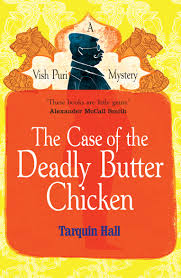
While at a banquet after an Indian Super League cricket match in which his nephew played, Vish is there when a visiting Pakistani falls dead, face down in a dish of butter chicken. Holy samosas! Vish had earlier espied this Paki skulking about in the garden, though he did admit that all Pakistanis skulk as far as he is concerned. This dramatic death throws Vish off the current case of the moustache-napper. There are contenders for the title of the longest moustache in India and they are being shaved in their sleep! The mo disappears and a clean lip remains. Nothing is sacred in secular India!
His team consists of Tubelight, Handbreak, Facecream, and assorted others contracted in when needed. Back in the office Madame coordinates. It is a smooth operation, usually, mostly, sometimes. He meets contacts around Delhi in air conditioned ATM lounges (cages), those glassed in ones, where he sticks up a ‘Closed’ sign to deter others while in conference. No tricks are missed.
Along the way, much Indian cuisine is consumed, and why not. He has stuck a dowel in the bathroom scales so his weight remains constant when Madame checks him, which is all too frequently.
The plot thickens with international gamblers, Scotland Yard detectives, a digital gecko, and more. It become necessary for Vish to travel to Pakistan! He spends some time trying to avoid it, but in the end, applies for a visa, and after more delay crosses the border, where he expects to be murdered immediately. He is astonished to find he is treated civilly and respectfully. In the end what drove him to go was not the case but the chance at tasting a delicacy in Lahore. This is not the cesspit of violence and corruption he had expected.
There is much about the terrible days of the Partition, enough to put anyone off religion as Muslims hacked up Hindis who happily reciprocated.
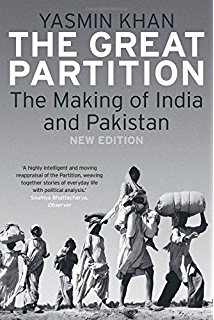 An unknown story to me.
An unknown story to me.
The sins of fathers and mothers live on.
In fact the murder was part of the long fall-out of those dark days. Much to his surprise Vish finds several Pakistanis who are stalwart and amiable, and they share information. But he also discovers that his Mummy, who has long had a penchant for interfering in his investigations, much to his annoyance, has a deep and dark past. In fact, she was a secret agent for the Indian Rescue and Recovery Commission during Partition and went on many dangerous missions, as one of his new Pakistani associates tells him with admiration. ‘Mummy!’ Vish cannot believe it but somehow it fits. Not a word has she ever spoken of those days.
Together they crack the case of the murder and also the international gambling, while the team finds the mo-napper.
Much of the subject is serious, but the touch is light, and while the history is detailed, it is crucial to the plot and focussed, as well as informative. I also found enlightening Vish’s defence of India as a society compared to Pakistan and its generals. India may have corruption and incompetence galore but it has never resorted to the rule of the gun. Another a good show.
‘Terror in the Midnight Sun’ (1958)
IMDb 1 hour and 5 minutes, 3.9/10 from 395 addicts.
Novelty value there is. This is a Swedish-American co-production, a rarity of the time. Moreover, it is set in the far north, Lappland, and features Sami in their costume. The ‘Seventh Seal’ also gets a look in. For the denouement read on.
 A Yankee lobby card.
A Yankee lobby card.
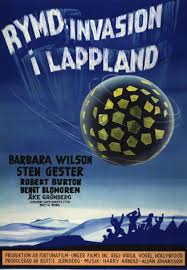 A Swedish lobby card.
A Swedish lobby card.
Prof is at a conference in Sweden and his niece, an Olympic athlete, is training up north, when a meteor strikes Sami country. Prof just loves meteors and takes no convincing to go look at the object that may have come ’from another world.’ It is a nice line and delivered with conviction by Robert Burton, instantly recognised from countless 1950s and 1960s television programs where he invariably played authority figures: judges, senators, colonels, deans, and even professors.
Barbara Wilson is the athletic niece who starts off confident, poised, smart, determined, and no nonsense, which fits the Olympic achievements, and she can skate and ski. After her character is established it is thereafter destroyed by endless demands to scream and faint, four times that were counted by the fraternity brothers between trips to the beer fridge.
What is all the screaming about?
Prof joins with a Swedish love interest for his niece and some police officers to go investigate. Many shots of the white blankness of snow fields and of Lapplanders in their curly-toed shoes and frilly hats, each designed to deal with the snow. While the testimony of the Lapps is treated seriously by the Swedish authorities, pretty boy is dismissive.
What testimony?
They say that the meteor glided in at a low angle for kilometres and then skidded for a distance on a nice soft snow bank. Gasp! It sounds like a controlled descent. Sure enough, Prof confirms it. Meteor just hit. Wallop! No gradual descent. Pretty Boy shrugs. This gesture turns out to be his dramatic range but he speaks English.
Just where the Lapps said, the Prof’s party finds the object and it is no meteor. It is the same ship that featured in ‘It Came from Outer Space’ (1955). Only part of it is visible in the snow bank. Much musing follows. Meanwhile, Hairy turns up. Hairy is big and hairy. BIG. He wanders around leaving enormous footprints which the investigators finally notice. Gulp. More musing.
The party divides. Some will stay on site. Others will go for help. Many will wait off camera.
Hairy grabs Niece who goes through her repertoire of screaming and fainting. It is King Kong all over again once more and anew. Hairy has found love and when she screams ‘No!’ he knows it is a come-on, and means try harder. He stashes her in a ice cave, and wanders around some more smashing balsa wood miniatures that someone spent hours making. Such are the frustration of interspecies love. Naughty, Hairy! But he is meeting his Yeti KPIs, that is Ka-blooie Performance Indicators.
Then his managers show up, and this is the best part of film. Three sketal skin heads in hoodies with bleached faces silently surround Niece, who…. [yep, screams and faints]. They do look like Death who played chess with the Knight in the ‘Seventh Seal’ (1957).
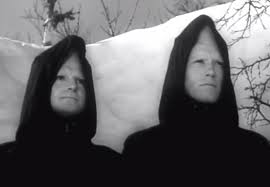 The Hoodies.
The Hoodies.
They an silent and stare at her. She screams and faints. Again. When she recovers, they point at an enormous footprint, and she screams and faints. Again. (Is it any wonder Barbara Wilson quit acting after this outing?)
They leave. Who knows why and where? Not the scriptwriter for sure.
Hairy returns and scoops her up as required in creature features. By this time the Samis are mobilised with torches. Remembers that scene from ‘Frankenstein’ (1931). Like that, except it is bright daylight on blinding show. They corner Hairy on a cliff edge over an abyss. Hairy thinks, ‘What would my hirsute brother King Kong do in a situation like this?’ To think he puts down Niece on a nice bed of snow.
While he is thinking the Lapps fling so many torches at him that all that hair he has catches on fire and on the ensuing excitement he falls over the edge into the abyss.
Pretty Boy then scoops up Niece and Prof muses over what just happened. So did I. ‘Dunno’ was the unanimous conclusion of the fraternity brothers.
Were the skin heads keepers of Hairy? Did Hairy escape and were they looking for him? If so, such inept aliens should have stayed home if they could not spot a thirty foot pile of black costume hair against the white backdrop. Or was Hairy a local and the skin heads wanted to Yeti-nap him for a zoo back on home world? But there was nothing earlier to indicate the neighbourhood had a Yeti problem. Were the skin heads surrogates for Commies, all quiet and insidious. Was Hairy a metaphor for….the Welfare State, Volvo hegemony, IKEA tyranny? Pick one! Pick two!
Apart from its resonances with other films of the ilk, it is distinguished by the exotic locale, long before SBS brought Norseland to the a television near everyone. All that snow. All those Swedish accents, and some Swedish spoken. (A film with even one untranslated sentence in a foreign language was often regarded as a box office killer in Hollywood.) The Swedes wear Swedish clothing. It looks like it was filmed there but the backstories on the web are not decisive.
There were two subsequent re-editings for the USA drive-in market. One is by Jerry Warren and the other by the unstoppable Roger Corman and released as ‘Invasion of the Animal People’ in 1959 with an opening voice over from John Carradine, who never said no to a gig.
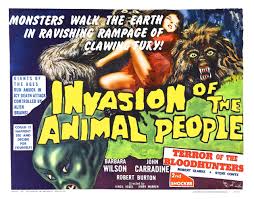 The Corman lobby card.
The Corman lobby card.
In these two versions nothing is left to the imagination. The Beast has come for women. He is looking for fraternity brothers with whom to party and needs a date.
Web critics disparage both versions. The IMDb does not distinguish among these derivatives. The You Tube version I found looks like the original.
‘When Worlds Collide’ (1951)
IMDb data: 1 hour and 23 minutes, rated 6.7 by 5824.
‘The End of Days is nigh!’ The Earth is doomed! Repent ye GOP voters!

Yes, astronomers have once again spotted a heavenly body intent on smashing the Earth, styled ‘Bellus’ and its attendant satellite ‘Zyra.’ Travelling thousands of kilometres a second, they will pass close to Earth in a few months and the passages will wreak havoc on Earth. The oceans will rise in giant tsunamis. The mountains will crack open to spew lava. The plains will continue to vote Republican. Much stock footage will be shown.
Or so claims the Lone Voice, while all his colleagues fatten their CVs by debunking his claims. Nonetheless Lone Voice pressed on and his conviction and data convince some backers to fund his fantastic scheme. Larry Keating of ‘Mr Ed’ played Lone Voice with great integrity and authority.
The plan is to build a rocket ship and hop onto Bellus as it passes. One of his financiers is a hard case, played by the ever reliable John Hoyt who gives the best performance in the ensemble. A team of six hundred specialists is recruited to build the ship and from those ranks, forty will be chosen at the last minute to make the flight. At every point the risks and uncertainties are emphasised. It is all rather Calvinist. Work as if chosen, but nothing can insure it. Most will have laboured in vain.
To equip the ship with knowledge a team of women sit at 1951 photocopiers rendering a reference library into microfilm. That was a nice touch. Though I did not notice Plato’s ‘Republic’ being included. Now where will they be packing the 1951 microfilm reader?
Everyone on Earth will die, that being the only way to kill the GOP virus.
Those that take flight may perish in the flight, die in a crash on Bellus, default on their AMEX payments, or find Bellus uninhabitable. Note, while passing by it will destroy Earth, but Bellus is unaffected in scriptwriter’s logic. The number forty was decided by bodyweight ever so finely calculated, though at the end Lone Voice added Barbara Rush’s boyfriend, a waif, and the waif’s pet dog. But to make way for them he stayed behind with the troublesome financier to face certain death. Is this noble of what. Babs, by the way, went on to ‘It Came from Outer Space’ in 1955 to cement her Sy Fy credentials.
The fatalism is out of time for 1951, when most Sy Fy movies overcame all odds.
There are conflicts among the rocketeers who are widely mocked by the ever responsible media, until the Earth moves under their feet. Then they mob the rocket site and have to be fended off. Good thing there was an arsenal included in the research grant. The testy financier had predicted this reaction and prepared for it while dreamy scientists had not.
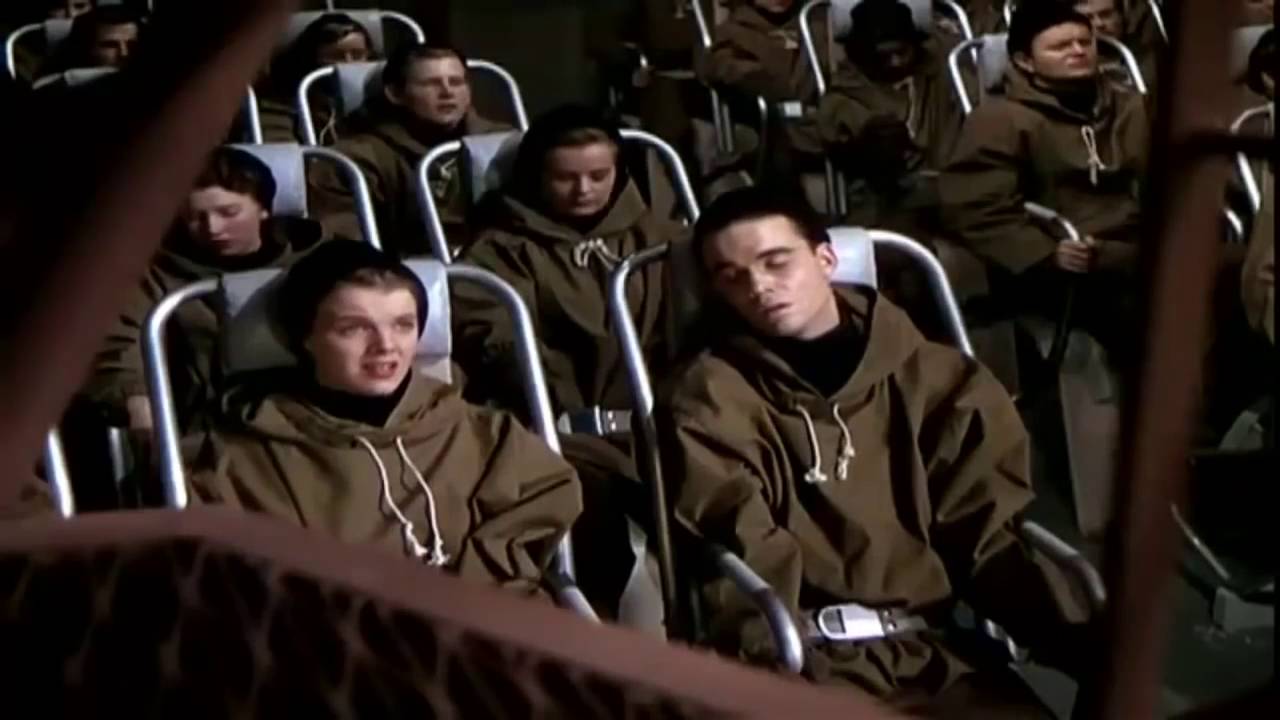
For reasons known only to rocket science the passengers wear a uniform of brown sweat suits and fly economy class without overhead storage bins for roll-aboards.
When the crunch comes, despite all efforts to avoid conflict, conflict occurs and the launch is compromised, but the ending is upbeat. While the Earth is split in an apocalypse, Bellus is green fields and blue skies (in pictures that look like they were ripped from a kindergarten classroom wall, as what must have been a late addition to the production, so out of keeping they are with the forgoing standard).
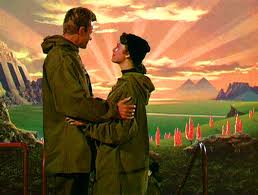
They made it and humanity can start its cycle of destruction anew! Whew!
There is much location shooting and an altogether big budget, mostly spent on the effects and not on big name actors.
The opening scene is an observatory in a remote South African location, and there are several subsequent references to other spaceship projects in other countries, but there is no technology transfer or cooperation among them. That seems realistic. There are never KPIs for cooperation.
The draw of the final forty seems to have been random, so it might yield forty tech heads who have never seen a vegetable or daylight. Neither does the six hundred nor the forty include any brown, red, yellow, or black faces. All whitebread, though, credit where it is due, many are women. For a New Eden science declares women are necessary. Amen, sighed the fraternity brothers.
Another Sy Fy offering from producer George Pal, known as the Happy Hungarian for his sunny disposition. He has many Sy Fy credits, some excellent, like ‘Destination Moon’ (1950) and the execrable ‘Conquest of Space’ (1957). Both are reviewed elsewhere on this blog. He tried to get the science right within the limits of the genre, the budget, and the capacities of the cast and crew.
‘Kronos’ (1957)
IMDb metadata is runtime 1 hour and 18 minutes, rated at 5.8/10 by 1392 raters.
An asteroid approaches Earth and science is mobilised! With flashing slide rules and pocket protectors, the equations lead the nerd brigade to only one conclusion. Blast it! (‘Haven’t we seen this before,’ whined the fraternity brothers? Patience, please.) But this asteroid uses the Delta Manoeuvre to elude the rocket’s red glare! Oh, oh! It seems intelligence is at work! Then the asteroid harmlessly slides into the Pacific Ocean off Baja California. Whew!
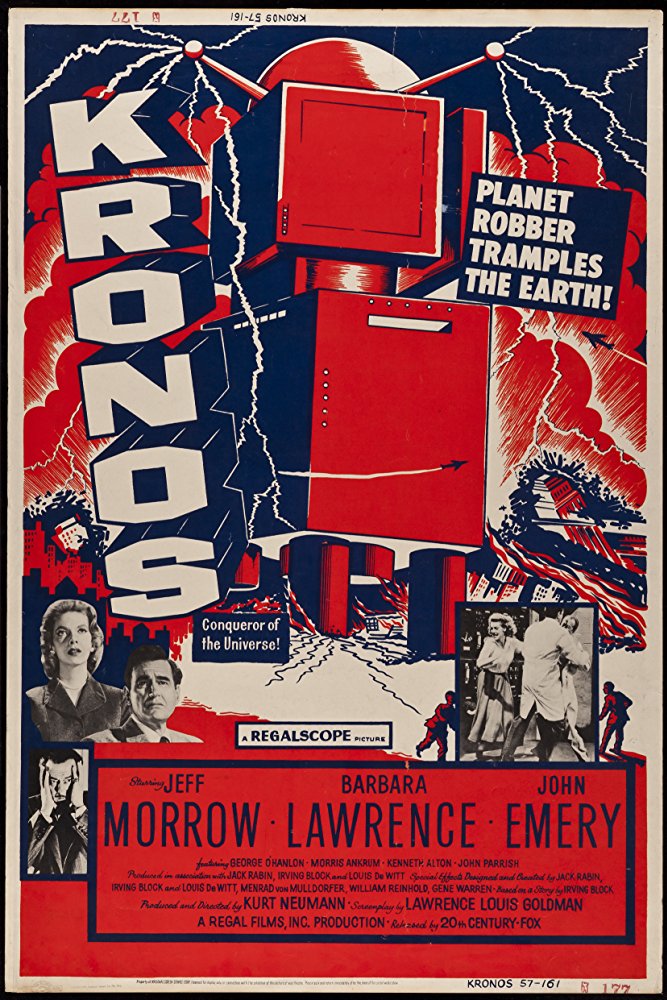
While it was passing over the desert south west (where the aliens get a special discounted rate) an orb split off and seizes the mind of the director of the nearest top secret defence laboratory. Sure. This new zombie had previously led a crew to Mars in ‘Rocketship X-M’ (1950), reviewed elsewhere on this blog. In that picture he was supposed to land on the Moon but missed it and hit Mars. Grounded! Once zombied he engages in silent communion, ever so cheap to film, with….Kronos! Kronos? Kronos.
While his soul is being devoured, his three top minions go to Mexico to observe the asteroid in the ocean. They observe each other, too. All is quiet on the asteroid front, so they get on with mutual observing, until… yes, right on cue a dome appears in the waters, and, no, it is not another water park, but a Kronos factory that emits Kronos 1.0.
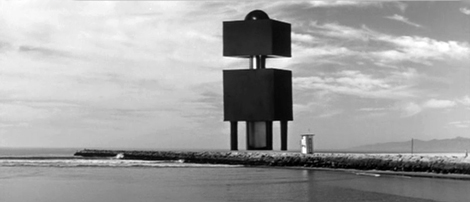
People have noticed that Dr Zombie is not his usual self and that Sy Fyian extra-ordinarie Morris Ankrum fails to collect on his bill!
Pause.
Kronos is a big TinkerToy. The trio borrow a handy Mexican helicopter for a closer look and land on the contraption just as it seems to stir, after a long-distance communion with Dr Zombie. They scoot and Kronos sets off, stomping through stock footage from a variety of locales, none of them Mexican. There is no further attempt to share Kronos’s pain.
Kronos sucks down electricity as it goes. It follows the grid to Lost Angeles!

In so doing it by-passes the much closer San Diego, because more stock footage of Lost Angeles is available.
The slide rules flash again, the giant main frame computer from ‘Desk Set’ (1957) flashes lights and what other conclusion could there be! Blow it up. More stock footage of boy toys. The attack of the boy toys does not slow Kronos. If only there had been a wall to keep out the Greasers! Kronos would have then stayed down Mexico way, supping on wattamales and voltstadas.
Somehow Jeff Morrow (after his frontal lobotomy addition in ‘This Island Earth’ [1955] [reviewed elsewhere on this blog] which by the way turned his hair white) figures it out. The Kronosians must have depleted all the non-re-newable energy sources on Krono and have come to Earth to stock-up. He also figures how to stop Kronos with wind farms and solar panels.
Remember ‘Clockwork Orange’ (by the way a giant Jackson No-Prize to the first person to explain why ‘A Clockwork Orange’ is called ‘A Clockwork Orange’ and not yellow or cerise)? Jeff did, and he gluts Kronos on so much juice not even Mylanta can help.
The female lead, who does not even have to scream, finally gets her big line to ask if more Kroni are coming. Jeff said all deadpan, ‘Dunno, but if they are we’ll be ready!’ The end.
Sorry, Jeff, but there was no vote of confidence from the fraternity brothers for that encomium. What we saw was comprehensively unready. The super top secret defence lab was penetrated by a truck driver with a wrench. The biggest scientist was zombied with a couple of flash lights. Mexico was drained of juice in a few hours. Lost Angeles had to be nuked. This is ready?
It is on the cusp between Sy Fy and creature feature. Kronos is not much of a creature, no drool, no fangs, no GOP ugly look, no Twit in Chief leer, no grabbing tentacles, and ‘it does not carry off a woman, as is mandatory in a Real Creature Feature,’ declaimed the fraternity brothers. Nor are the electricity effects up to Dr Frankenstein standards. More like a bulb going out in the frat house than an eye-popper.
On the other hand, the acting is uniformly good. Jeff looks interested in the science de gook, and the Zombie’s inner turmoil is apparent, and Morris Ankrum is also pitch perfect, as always. The director keeps it moving. But the stock footage is not well chosen, nor well integrated. The miniatures for Kronos are nothing special, even for the times.
Interpretions of the symbolism can keep the fraternity brothers happy for hours. Is Kronos, the accumulator of energy, a metaphor for the unbridled consumerism of the era? For the insidious effects of Communism? For creeping managerialism that leaves empty KPI husks behind? For the spectre of technological growth represented in this film by a computer system called SUSIE that adds nothing to the proceedings? Or is a Trojan TinkerToy? Is Odysseus inside?
‘Gog’ (1954)
Computer hackers get control of Siri and Alexa!
IMDb meta-data is 1 hour and 22 minutes, rated at 5.5/10 by 822 raters.
The third and last of producer Ivan Tors loose sequence of stories about the fictional Office of Scientific Investigations, represented here by Richard Egan, who is summoned to shoot trouble.
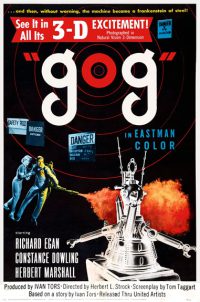
Deep in the desert southwest, where else, in an underground laboratory, designed to withstand an atomic blast or one speech by the Twit in Chief, that nation’s best scientists labour to bring forth the first space station, before ‘They do.’ Yep, 1954, with the Korean War still Red and raw.
The Yankees have entrusted this super-duper top most secret facility to a one legged Brit by the name of Herbert Marshall, with his owlish eye glasses. Immigrants even in those days took American jobs!
‘What’s the trouble?’ The scientists are being murdered! Two were frozen, one after another, in the cryogenics lab. A radioactive pot plant crisps another. The whirly gig takes out two more. The body count rises in the Laboratory of Otranto, while Egan tours the several levels of the bunker. Is he bad luck or what?
The whole establishment is run by an IOS Home computer called NOVAC, which has two robot minions, Gog and Magog. Why names from the Book of Ezekiel are used is anyone’s guess. There is no explanation in the film.
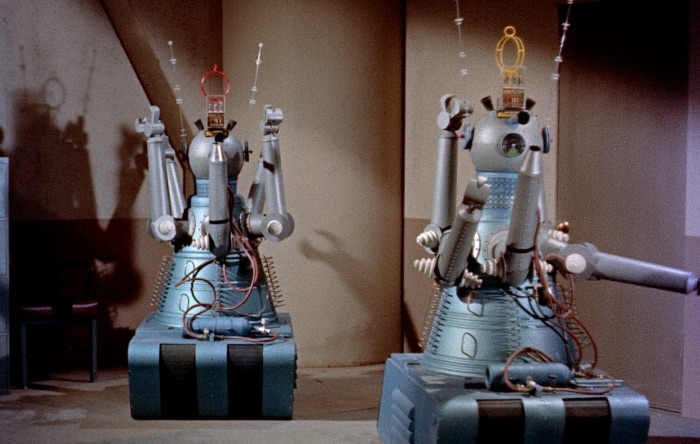
These robots are precursors of Daleks with their waving arms and tank treads. They are as useful as Siri and Alexa. They can open doors, hand over screwdrivers, and strangle Mr Pomfrit. In addition, the lab has solar energy in use, and a sound laboratory full of deadly tuning forks. Yes, it is a lavish and inventive production.
The body count rises. Turns out NOVAC has been hacked by ‘Them’ and is itself destroying the Nobelists by using Siri and Alexa before they can give long, boring, pointless speeches, forgetting to mention the underlings who did all the work. Egan figures this out about an hour after the fraternity brothers did, and sets about thwarting it. How?
He calls in the USAF to shoot down an airplane that is always overhead. See, what I said about slow. The evil virus code is being transmitted from that aircraft. Stock footage of Saber jets taking off and in mid-air transformed into Thunderbirds. Kaboom! So much for that TWA flight.
Before that crescendo, Egan has to fight both Siri Gog and Alexa Magog mano à mano, well, with a flame thrower. Just the sort of thing to keep around super-duper top most secret deep underground laboratory working on space flight. In fact, they have two of the contraptions that have always killed more operators than enemies.
But wait, the plot thickens. How could good old American code be hacked? In the world of defence contracting it turns out Heidi built the robots in the Swiss Alps, and it must have been there that ‘they’ infected them with a virus which the bots in turn imparted to NOVAC. Moral? Build your own robots. That is a new twist on Cold War paranoia, blame the Swiss neutrals. Boycott Lindt!
In the interest of science there is some concern about radiation. Everyone wears a badge that reacts to it as a warning of exposure. When the killer pot plant is approached, the technician wears a hazard suit and uses some long kitchen tongs, dropping the killer ingot into a lead lined box. Good. Trouble is Egan, his girl Friday, and several gawkers peer over the hazard suit’s shoulder to watch the proceedings from two feet away.
Later they recover from a little radiation by lying down with aspirin.
Much of the first thirty minutes is an exposition of the different parts of the facility and an introduction to the scientists who occupy them, leading the viewer to suspect that the culprit is among them. Indeed, Egan says that at one point. That was a nice bit of indirection.
The scientists are all just west of mad and most have highly suspicious accents. Each has the ego of brain surgeon and the personality of a CPA at tax time. They have accomplished such astounding things as burning balsa wood models. No wonder they think so highly of themselves. Although, come to think of it, that is more than some egomaniacs of my acquaintance have done.
‘The Angry Red Planet’ (1959)
IMDb metadata: 1 hour and 23 minutes, rated 5.2/10 from 2356 opinionators.
Rocket M1 is en route, that is Mars One. It left Earth more than two months ago and nothing has been heard from it since it was scheduled to land on M A R S! Then it appears in the sky, Earthbound. Putting new batteries in the remote control, ground control lands it by pushing a lot of buttons. The procedures of the operation are shown in some detail, including concern for radiation.
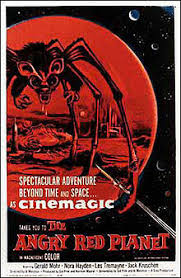
Turns out things did not go well on Mars. There were four crew members, but in return only two remain alive, and one of those has been slimed. Wow! The details emerge in flash back from Irish Iris, who is traumatised by the screenplay. Who can blame her. She is a many PhDed biologist who is consigned to screaming.
The original crew also included Jock, who is the working class comic annoyance, Doc who smokes his pipe thoughtfully, and male lead, Gerald Mohr, who made a career in B-movie land out of a vague resemblance to Bogie. And Iris(h) makes four.
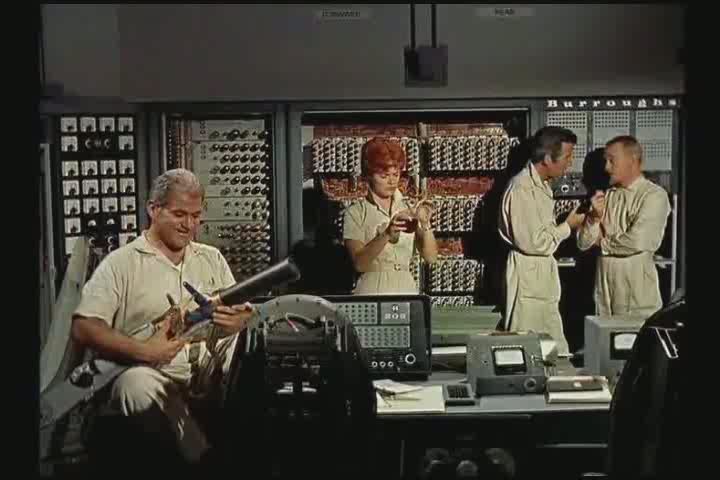 The crew on Mars.
The crew on Mars.
The players are all experienced and able. The direction is adequate, apart from the comic annoyance. Whenever he appeared the fraternity brothers cried, ‘Cut!’
They land on a very red Mars.
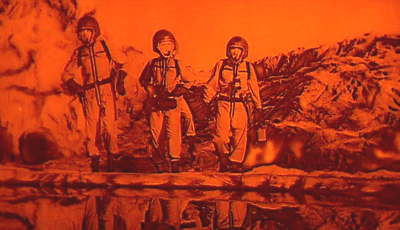
This is 1959 and there are Reds under the beds as it is. Why go looking for more? There is no answer as to the purpose of the expedition.
What they find is a red jungle. Donning overalls with scuba masks, they venture out into the red filter and find… a jungle. Iris collects samples galore, and one of them tries to collect her. While Gerald has a six-gun — that he loaded before cleaning in the NRA-approved method! — and a sound bazooka, that is so cheap it does not make a sound. It wilts the plant. (By this time the space suits made for ‘Destination Moon’ [1950] must have been worn out from use in so many other films.)
Earlier they had to spray a bat-rat-spider (who knows). They espy the spires of a city in the distance across a lake. Yep, a lake wherein dwells an ugly Republican Senator who devours Jock. A word of thanks came from the fraternity brothers.
Now they rush back to the ship. It seems stuck but they struggle for lift-off, much as I did this morning, and while so doing, a voice comes over the speaker, a pleasing baritone, that tells them to scat. ‘No destructive Earthling immigrants are wanted on Mars’ gardening and exterminating. ‘Stay on Earth and kill each other,’ says the voice.
In the whirl, Gerald got slimed and retires to his cot. Doc and Irish throw a lot of switches and blast off, without following the checklist of procedures, with the result that Doc is crushed, pipe in hand. Iris did buckle up and survives but is rendered unconscious. Gerald has a green arm. Is he an incipient Green-voting bore in the making?
All of this is told in a flashback that is far from flashy.
Once back on Earth, Iris figures out what’s wrong with his arm and kisses it better. The end.
Huh? Can Reds on Mars exclude freedom-loving Yankees from Mars? No way! Is Mars a metaphor for Eastern Europe behind the Red Curtin. Time for Radio Free Mars to go on the inter-planetary airwaves. Drop gardening manuals and blue blockers to open the eyes of the downtrodden. The blue blockers will cut the red mist. Some gardening will make the lush Martian jungles Yankee-friendly. This is the Martian Plan.
We never see the Martians, just their pot plants and house pets, and the distant spires painted on a matte. But who are they to say ‘Yankee go home, and stay there!’
The word is that it was done in ten days, using a new filter that sometimes makes Mars and the space suited crew look like cartoons. This look was unintended but there was neither time nor budget to do anything but go with it. Likewise the creature models were not quite what the director expected but he had no choice but to use them.
Speaking of the director, it seems that he and scriptwriter have since duked it out in conventions and screenings for thirty years over which one was genius responsible for the film. Really. Say no more.
‘Invasion U.S.A.’ (1952)
IMDb metadata is 1 hour and 13 minutes of Dali run time, rated at a generous 2.7/10 by 944 raters.
A group of people sit in bar and talk. That sums it up. About three-quarters of the film is stock footage from World War II of shells exploding, soldiers soldiering, airplanes flying, bombs falling, destroyed buildings, and on and on.
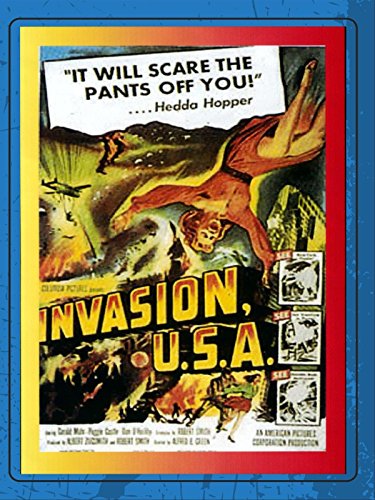
The sitters are in a New York City sports bar and they watch the progress of nuclear war on television. The ‘enemy’ lands paratroopers in Alaska, and pictures of Germans landing in Crete are shown. That mix up is typical. There are references to jet planes when propeller planes are shown. Washington state and Washington DC are run together. The script is so sloppy that the Illinois Congressman in the bar is later posthumously elevated into a Senator.
The enemy is never named but we know who it is.
There follows bombings here, there, and everywhere. Sometimes they are called atomic bombs and sometimes not. More paratroopers paratroop against back projections of Capitol Hill. Is no where safe? Yankee Stadium?
In addition to the sitters we see four Americans in ill fitting, mixed uniforms sitting around a table telling each other the bad news in excruciating dialogue so bad that — believe it or not — McKinsey-speak would be better.
Occasionally we see six or eight others in drab uniforms and thigh boots shouting at each other in a variety of enemy accents, Latino, Slavic, Brooklyn, German, Armenian, Italian, Texan.
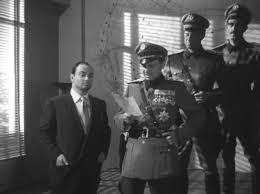
They go on about liberating the masses in a people’s government. The creeps! Wait until 1985 when cute little Chuck Norris gets ahold of them! He’ll kick ’em right in the knee, if he can reach it.
The barflies earlier bemoaned the heavy hand of government, of crushing taxes, of waste in defence spending, of watered drinks, of paper work, while the bartender boasted of ducking the last war, cocktail shaker in hand. Consequently, the US of A does not have the army, the weapons, or the will power to repel the Enemy!
When the going gets tough, however, the barflies become Minute Men and Women. The men rush to factories to produce tanks, to the ranch to produce food, to the library to pay overdue book fines, to the blood bank to give blood, to the blood bank to take blood….but it is too little and it is too late. The Enemy prevails across the nation. Leaving little to the imagination, there is also a rape. According to the fraternity brothers, whose expertise on such matters is complete, it was no worse than a NCAA football team on the loose.
Seattle, Omaha, San Francisco, Minneapolis, New York City are all levelled. There being no limit to the dastardly enemy’s evil, he blew up the Boulder Dam. The Enemy is frequently referred to as ‘he.’
Then…the sleepers awake from this nightmare. It seems Mr Ohman, Omen (Get it?), put them all in a trance with his restful Irish brogue combined with their many post-lunch martinis. Long before RoboCop, this is Dan O’Herlihy who describes himself as a forecaster, and this is his forecast.
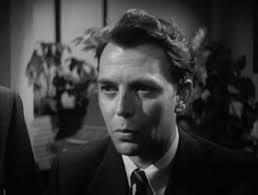 The enigmatic Mr Omen.
The enigmatic Mr Omen.
He is marvellous in his smug superciliousness with an air of detached mystery. His purpose is for these barflies to see the errors of their ways. They do. As he departs (without leaving a tip) they are changing their ways. The only woman in the bar changes beaus.
Yet 2.7 seems too high and the Finn gives it 1/10 only because he does not give 0s. It is nearly unwatchable. My pants were safe, contrary to Hedda Hopper’s prediction on the lobby card reproduced above.
In earlier scenes of the nightmare we saw lines of people at the New York City Airport trying to fly home, as one would during a nuclear war, and the two ticket agents were Lois Lanes from the Superman franchise, Noel Neill (in the 1948 film serial and later the television series with George Reeves) and Phyllis Coates (in ‘Superman and the Molemen’ of 1951).
William Schallert also puts in a brief and late appearance as a news reader. He’ll always be Mr Pomfrit to me and Dobie.
The surprising thing is that such a turkey was made by an experienced and talented cast and crew. One singular indicator of the incompetence on view is this: Twice the US President is shown on television calling for calm. Each time he is seen from the rear! We never see his face. Just a 3/4 profile from his rear left side. At first I thought this was somehow important later I realised it must have been a mistake and with no budget for re-takes it was used as is. The speaker was Joseph Granby, uncredited, but very reassuring.
The set-up has promise: are they really watching World War III on television? In addition to the RoboCop chief and the Lois Lanes, there is also Gerald Mohr and Peggy Castle, each with a long list of creditable performances in other movies. Likewise the director and producer have solid credentials. The writer had a Hugo nomination for one of his other screenplays. Yet taken together….. well, don’t.
It does demonstrate the paranoia of the time, but not very well compared to many other films.
While hardly Sy Fy, the obsessive Finn (Scifist) includes it in his list and so I had a look.
‘Meteor’ (1979)
IMDb metadata: 1 hour and 46 minutes rated 4.9/10 from 5730 raters.
A big budget disaster movie from the era of big budget disaster movies. The clichés are all there: the solitary Chicken Little, the fetching femme, the stalwart buddy, the doubting Thomases, the extras to become victims, the special effects of falling bricks and rising waters. But it does have some twists that set it slightly apart.
The set up is this: A large object is on a collision course with Earth! Only James Bond, once again, can save the world. With half-hearted grousing he is summoned for reasons that never become clear since he does nothing thereafter but snipe at others. President Henry Fonda mouths lines. Trevor Howard has a few moments to impart some purpose.
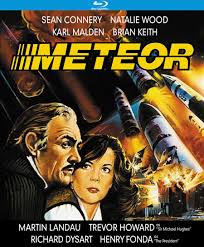
The twist is that to destroy the Really Big Space Rock will take the combined effort of the USA and the USSR. Much mutual suspicion is exercised, but in the end the Soviets agree and trust the mission, controlling fourteen USSR nuclear warheads to one scientist and a translator, whom they send to New York City. Sure. That is the way the Kremlin worked in 1979. The Russians are coming.
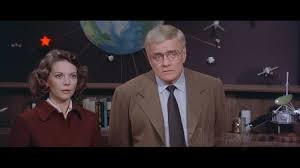 The scientist is the redoubtable Brian Keith who does it well, and his translator is a very drawn Natalie Wood, who adds grace to anything.
The scientist is the redoubtable Brian Keith who does it well, and his translator is a very drawn Natalie Wood, who adds grace to anything.
The USAF in the person of Martin Landau opposes everything with childish temper tantrums. Salute that! Don’t blame Marty because he is written that way.
Together the Russkies and the Yankees blast the rock but shards still strike Earth giving us some nice disaster scenes. Yuk. Bond saves everyone.
By the time this one was made the disaster tire had no tread left on it. All the tropes are there but everyone from the scriptwriter to the extras seems bored by it. Karl Malden puts the most into his part, and Keith seems to enjoy the language barrier, but Bond and the ethereal Wood seem to be waiting for it to end. So did I.
Richard Crenna in ‘A Fire in the Sky’ (1978), reviewed elsewhere on this blog, did the same part as Sean Connery in this film, and Crenna did it better – more energy, more intelligence, more conviction, and he had material that had some science and some compassion in it. This film seems to rest entirely on the big names in the cast, and they in turn go through the motions as quickly as possible.
The rockets in space was a neat idea and well presented for the toy model special effects used.
This block buster was delayed in production in the effort to improve it. Failed. The ‘New York Times’ reviewer, Jane Maslin, nailed it: slow, sludge, half-baked, boring. Those were her kindest remarks.
‘A Fire in the Sky’ (1978)
IMDb metadata: 180 minutes @ 6.6/10 from 333 raters
The scientists agree a meteor is headed for Phoenix! Whoops! The scientists do not agree! Is it a meteor or comet? Will it hit Earth or pass by? If it hits where? If it passes by, then how close? How big is it anyway? There is disagreement among the boffins on each and every point.
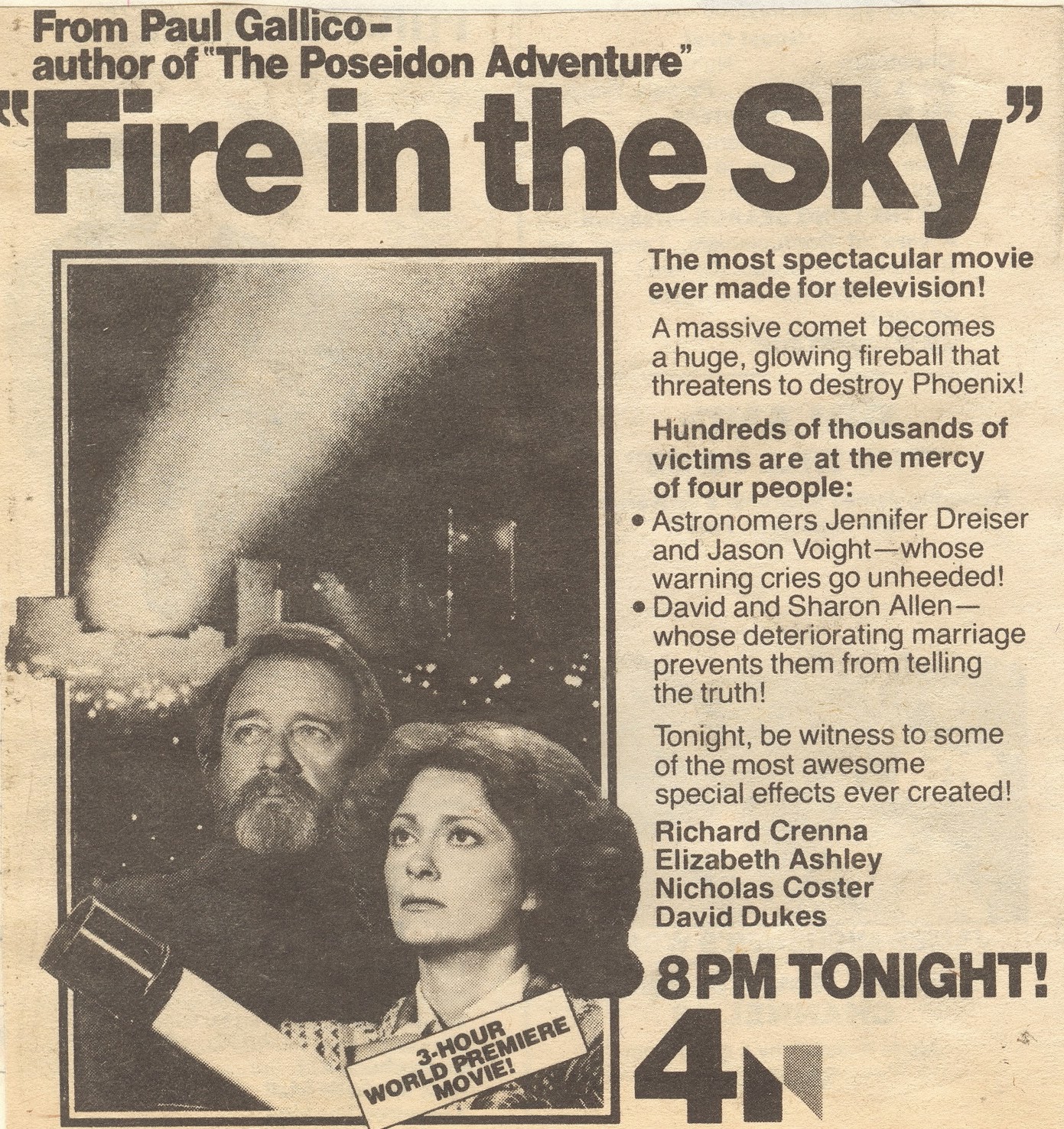
In a roomful of PhDs all the KPI career incentives reward disagreement, even at the end of the world. The bickering, logic chopping, semantics emerge to mask the egotism, opportunism, and careerism. Seminar normal.
The local political decision makers decide the financial disruption of an alert is too great. This decision is partly based on the belief a panic would ensue with loss of life, destruction of property, and worse, the arrival of Fox News. They are also sure that there they do not have the infrastructure of shelters or trained personnel to do anything constructive. No one wants to pay taxes for comet shelters.
Journalists, of course, know better and strive to tell all without regard to consequences! Situation normal. They tell all and panic ensues with the loss of life which in journalism logic is vindication.
In Arizona the gubernatorial response remains guarded and equivocal. After all only one scientist is doing Chicken Little. Why is he right and everyone else wrong? Because the script says so, that’s why!
Meanwhile, the USAF applies the usual foreign policy response: blow it up. But the rocket misses. Whoops! So much for that.
The script includes a lot of science, including a distinction between a comet, asteroid, and a meteor. Despite the summaries and reviews on the net, in fact, the political decision making is shown to be careful and sensible. At first the Air Force general is reluctant to go the expense of a missile launch on the say-so of one scientist, but in the end there is a pre-emptive rocket fired and it is a miss, a near miss, but a miss. But the screenplay also includes far too many sidebars that blur the focus. Merlin Olsen is a treat but out of place. Ditto the thwarted young lovers.
Andrew Duggan imparts dignity to the proceedings as President. Governor Dukes lays out the complexity of the social consequences. But Richard Crenna carries the film with integrity and conviction. Particularly striking was his effort to frighten the child as a way of showing the parents what the reality of the situation was likely to be. That was surprising and effective, and done with conviction. He learned a lot from ‘Our Miss Brooks.’
The direction is leaden but perhaps that is because the material was stretched to 180 minutes! Had it been halved the pace would have been better.
The 1970s fashions are much in evidence, aviator glasses, wide neckties, hirsute faces with flared trousers, altogether enough to put off any time traveller.
The original plan was to air it on television after the theatrical release of the big budget ‘Meteor’ (1979) to ride its publicity coat tails. (Its IMDb score is 4.9.) But with the big budget went big egos and that production languished and in fact ‘A Fire in the Sky’ went to air first. Best laid plans and all that.
